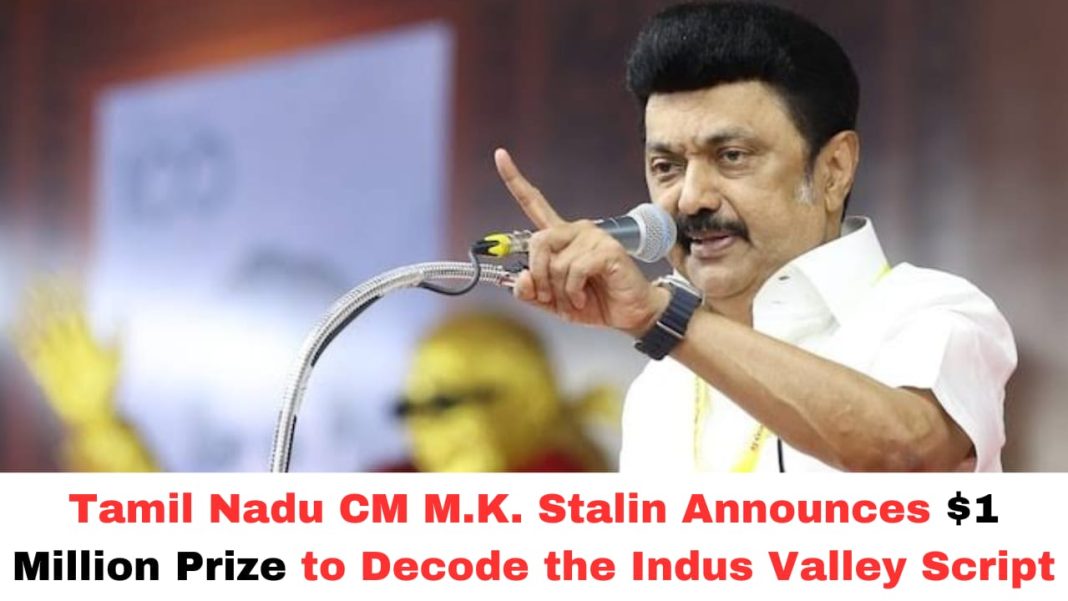Digital New Guru Tamil Nadu Desk:
In a groundbreaking initiative to uncover the mysteries of one of the world’s oldest civilizations, Tamil Nadu Chief Minister M.K. Stalin has announced a $1 million prize for anyone who can successfully decipher the ancient script of the Indus Valley Civilization. This remarkable announcement was made during an international conference in Chennai, commemorating the centenary of the discovery of the Indus Valley Civilization by British archaeologist Sir John Marshall in 1924.
The initiative has sparked global attention and has been hailed as a major step toward understanding the roots of South Asian history and culture.
The Mystery of the Indus Valley Script
The Indus Valley Civilization, which flourished from approximately 2600 BCE to 1900 BCE, was one of the most advanced urban cultures of its time. Known for its sophisticated urban planning, drainage systems, and trade networks, the civilization left behind numerous artifacts, including seals inscribed with a script that remains undeciphered.

This script, composed of pictographic and symbolic elements, is believed to represent a language spoken by the people of the Indus Valley. However, due to the lack of a bilingual inscription (similar to the Rosetta Stone for Egyptian hieroglyphs), the script has eluded scholars for over a century.
Unlocking the meaning of these symbols could provide invaluable insights into the civilization’s social structure, economy, and cultural practices. It could also shed light on the linguistic and cultural roots of contemporary South Asian societies, particularly those in India and Tamil Nadu.
Dravidian Connection and Tamil Roots
Chief Minister Stalin emphasized the potential connection between the Indus Valley Civilization and the Dravidian culture. During his address, he noted that symbols such as the bull, frequently depicted in Indus Valley seals, still hold significant cultural and religious importance in Tamil Nadu. He suggested that the Indus Valley Civilization could represent an ancient Dravidian culture that predates the Aryan influence in South Asia.
Stalin’s assertion aligns with the views of several scholars who believe that the language represented in the Indus script may be an early form of a Dravidian language. Tamil, being one of the world’s oldest living languages and a member of the Dravidian family, has often been linked to this theory.
By offering a $1 million prize, the Tamil Nadu government hopes to incentivize scholars, linguists, and cryptographers worldwide to solve this long-standing mystery, potentially validating the Dravidian roots of the Indus Valley Civilization.
Supporting Research and Academic Contributions
In addition to the prize, Stalin announced a 2 crore grant to establish a research chair named after the eminent scholar Iravatham Mahadevan, a pioneer in Indus script studies. The chair will be part of the Indus Research Centre at the Roja Muthiah Research Library in Chennai.

The government also plans to institute annual awards to honor two scholars—archaeologists, epigraphists, or numismatists—who make significant contributions to uncovering the antiquity of Tamil culture. These initiatives are expected to bolster research in Indus Valley studies and promote interdisciplinary approaches to decipher the script.
Global Interest and Academic Challenges
The Chief Minister’s announcement has reignited global interest in the Indus script, drawing the attention of experts from diverse fields, including linguistics, archaeology, artificial intelligence, and cryptography. Some researchers are exploring computational methods and machine learning to analyze patterns in the script, while others are revisiting historical and cultural contexts for clues.
However, the challenge of deciphering the script remains formidable. Unlike other ancient scripts such as Egyptian hieroglyphs or Mesopotamian cuneiform, the Indus script lacks long texts and appears primarily in short inscriptions on seals, pottery, and other artifacts. The brevity of the inscriptions, combined with the absence of a direct translation or known linguistic relatives, complicates efforts to crack its code.
Despite these challenges, the Tamil Nadu government’s bold initiative has inspired hope and enthusiasm. By offering a significant monetary incentive, it aims to attract fresh perspectives and innovative methodologies to solve one of archaeology’s greatest puzzles.
Significance for Tamil Nadu and Global History
For Tamil Nadu, deciphering the Indus script could affirm the historical and cultural continuity between the Indus Valley Civilization and modern Tamil society. Such a breakthrough would not only deepen the understanding of Tamil heritage but also elevate its global prominence as a region with roots in one of humanity’s earliest urban cultures.
On a broader scale, the initiative underscores the importance of preserving and studying ancient civilizations. Unlocking the secrets of the Indus Valley could offer new perspectives on human development, trade, governance, and cultural exchange during the Bronze Age.
Conclusion
Chief Minister M.K. Stalin’s announcement of a $1 million prize to decipher the Indus Valley script is a bold and visionary step. It reflects Tamil Nadu’s commitment to preserving its heritage and advancing global historical research.

The initiative has the potential to unravel a centuries-old mystery, bridging the gap between ancient and modern civilizations. Whether through linguistic breakthroughs, technological innovations, or collaborative scholarship, the world now watches eagerly for the day when the secrets of the Indus script are finally revealed.
You May Also Read: Aamir Khan Praises Son Junaid’s Performance in ‘Loveyapa’ and Draws Parallels with Sridevi’s Legacy








